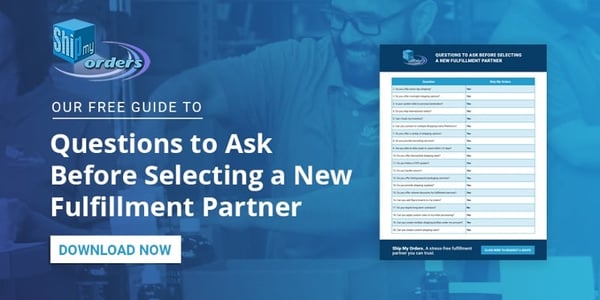Switching 3PL Providers Without Disrupting Operations: Is it possible?
.png?width=600&height=314&name=Ship%20my%20Orders%20Blog%20%237%20(1).png)
Are you considering switching 3PL (Third-Party Logistics) providers but worried about potential disruptions to your operations? Making a change in your logistics partner can be a daunting task, as it involves transitioning your entire supply chain management to a new provider.
However, with careful planning and execution, it is indeed possible to switch 3PL providers without causing major disruptions to your operations. In this article, we will explore the steps and strategies you can follow to ensure a smooth transition and minimize any potential setbacks.
Understanding the Need for Switching 3PL Providers
Before diving into the details of the transition process, it's essential to first understand why your business may need to switch to 3PL providers. There are several reasons why companies decide to make a change in their logistics partner:
-
-
- Performance Issues: If your current 3PL provider consistently fails to meet their service level agreements (SLAs), resulting in delayed shipments, inventory inaccuracies, or poor customer service, it might be time to consider alternatives.
- Scalability: As your business grows, you might need a 3PL provider with the infrastructure and capabilities to support your expanding operations. If your current provider cannot meet your increasing demands, switching becomes necessary.
- Costs: If you believe your current 3PL partner is charging excessive fees or not providing cost-effective solutions, exploring other options could lead to potential savings.
- Technology and Innovation: In today's fast-paced business environment, staying ahead of the competition requires leveraging the latest technologies and innovative logistics solutions. If your current provider lags in these areas, seeking a partner with advanced capabilities may be beneficial.
- Geographical Reach: If your business expands into new markets or needs to serve customers in different regions, switching to a 3PL provider with a broader geographical reach can enhance your logistics capabilities.
-
The Transition Process
Transitioning from one 3PL provider to another requires careful planning and execution to minimize disruptions and ensure a seamless transfer of responsibilities. Follow these steps to facilitate a smooth transition:
-
Evaluate Your Current Situation
Before initiating the transition process, conduct a comprehensive evaluation of your current logistics operations. Identify the strengths and weaknesses of your current 3PL provider and document any areas that need improvement. This evaluation will help you set clear goals and expectations for the new provider.
-
Define Your Requirements
Outline your specific requirements and expectations from the new 3PL provider. Consider factors such as service levels, scalability, technological capabilities, pricing, and geographical reach. Communicate these requirements to potential providers during the selection process.
-
Research and Shortlist Potential Providers
Conduct thorough research to identify potential 3PL providers that align with your requirements. Consider factors such as industry experience, track record, client testimonials, and technological capabilities. Shortlist the providers that appear to be the best fit for your business.
-
Request and Evaluate Proposals
Reach out to the shortlisted providers and request detailed proposals outlining their services, pricing, and implementation plans. Review these proposals carefully, comparing them against your defined requirements. Pay close attention to contractual terms and any potential hidden costs.
-
Perform Due Diligence
Perform due diligence on the shortlisted providers before making a final decision. This might involve checking their references, visiting their facilities, and conducting interviews with key personnel. Ensure the provider has a strong financial standing and a solid reputation in the industry.
-
Create a Transition Plan
Develop a comprehensive transition plan in collaboration with the selected 3PL provider. This plan should outline the detailed steps and timelines for the transition process. It should cover areas such as data migration, inventory transfer, system integration, and training of personnel. To prevent misunderstandings throughout the transfer, clearly identify roles and duties.
-
Communicate with Stakeholders
Effective communication is crucial throughout the transition process. Keep your internal teams informed about the impending change and its potential impact on their roles and responsibilities. Communicate with your customers and suppliers, ensuring they are aware of the switch and any temporary disruptions they may experience. Provide clear channels of communication for any questions or concerns.
-
Test and Monitor
Before fully transitioning to the new 3PL provider, conduct thorough testing to ensure all systems and processes are functioning correctly. Monitor the transition process closely, tracking key performance indicators and addressing any issues or bottlenecks promptly. Regularly communicate with the new provider to evaluate their performance against the defined expectations.
-
Continuous Improvement
Once the transition is complete and operations are running smoothly with the new 3PL provider, continue to monitor their performance and periodically reassess your logistics needs. Establish regular feedback mechanisms to address any concerns or areas for improvement. A partnership with a 3PL provider should be an ongoing collaborative effort focused on continuous improvement.
The Potential Benefits and Risks
Switching 3PL providers can bring significant benefits to your business, but it also comes with inherent risks. Let's explore some of the potential advantages and challenges:
Benefits
- Improved Performance: A new 3PL provider that aligns with your requirements can significantly enhance your logistics performance, resulting in improved customer satisfaction and operational efficiency.
- Cost Savings: A well-chosen 3PL partner can provide cost-effective solutions that help optimize your supply chain and reduce logistics expenses.
- Technological Advancements: Switching to a provider with advanced technologies and innovative solutions can give your business a competitive edge.
- Scalability: A capable 3PL provider can adapt to your changing business needs and support your future growth without operational disruptions.
Risks
- Transition Challenges: The process of switching 3PL providers can be complex and time-consuming, potentially leading to temporary disruptions in operations.
- Data Accuracy and Integration: Data migration and integration between systems can pose challenges, requiring proper planning and coordination.
- Supplier and Customer Communication: Ensuring effective communication with suppliers and customers during the transition is vital to manage expectations and minimize disruptions.
- Loss of Institutional Knowledge: With a new provider, there is a risk of losing the institutional knowledge accumulated with the previous one. Proper knowledge transfer and training can mitigate this risk.

For Ship My Orders, switching 3PL providers is not a complex undertaking, with careful planning and execution, it has become possible to minimize disruptions and ensure a smooth transition. Evaluate your current situation, define your requirements, and thoroughly research potential providers before shortlisting and evaluating proposals. Communicate effectively with stakeholders and develop a detailed transition plan.
Monitor the process closely and continuously improve in collaboration with the new provider. Be aware of the potential benefits and risks associated with switching 3PL providers. By following these steps and considering the challenges, you can successfully switch 3PL providers without disrupting your operations and set yourself up for enhanced logistics performance.


-1.png)


